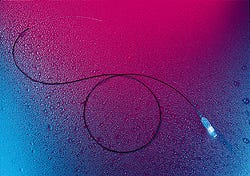June 1, 1997
CASEBOOK 1
Surface Modification Improves Performance of Microcatheter
Helps reduce friction caused by tortuosity of brain vessels

When Target Therapeutics (Fremont, CA) introduced its Tracker microcatheter, which permits examination of the distal portions of the brain, the new product was quickly accepted by radiologists. The next step for the manufacturer was to improve the microcatheter using a coating that would reduce the friction created by the tortuosity of the brain vessels. Such a coating--with high lubricity and tenacity--could provide enhancements such as more accurate placement of the catheter, greater insertion speed, increased patient comfort, and expanded access.
That goal was realized when BSI Corp. (Eden Prairie, MN) used its PhotoLink technology to specially tailor a surface modification for Target's catheter. Trademarked Hydrolene, the surface technology allowed for a 2-µm-thick chemically bonded hydrophilic polymer to coat the FasTracker catheter. Application of the low-friction coating is a two-step process, requiring coating of the exterior surface of the catheter with preformed polymers which are then activated with UV light.
Tests show that the Hydrolene coating reduced push/pull force within a guiding catheter by more than 50%. And after 20 pulls through the guide, the FasTracker maintained its lubricious characteristics. This improved adherence is produced by the covalent bond inherent in the PhotoLink technology. In addition, studies show that platelet aggregation and creation of clots through adherence of blood components to the surface of a catheter coated with Hydrolene is less than with an uncoated catheter or a catheter coated by other methods.
Robert Hergenrother, manager of applied research at Target, helped develop the FasTracker and was instrumental in specifying BSI's coating. "Their coating was fairly easy to apply," he says. "The chemistry was relatively benign, soluble in water and alcohol rather than some other solvents. And it worked without much modification to our base product."
BSI's technology also helped reduce Target's manufacturing costs. The silicone-based coating previously used required batch processing. Hydrolene, on the other hand, permits nearly continuous product manufacturing, allowing faster turnover and shorter cycle times. Replacing batch manufacturing with a continuous-stream processing system helped lower Target's production costs.
Target reports that physicians are enthusiastic about the performance of the Hydrolene-coated microcatheter. Target's original goals--more accurate placement of the catheter, greater speed, better patient comfort, and the ability to reach previously inaccessible areas of the brain--were all met.
"We needed Hydrolene in order to stay competitive," says Hergenrother. "It allowed us to improve our product line and to protect our market share. In addition, this technology has probably allowed us to think more aggressively about modifications and optimization of our devices."
For more information contact BSI Corp. at 510/440-7700.
You May Also Like


